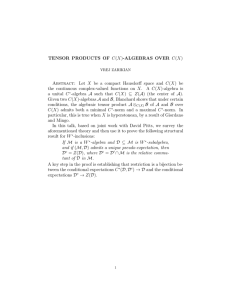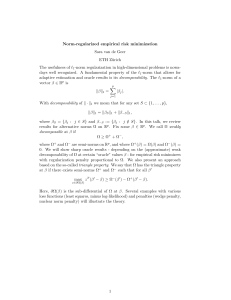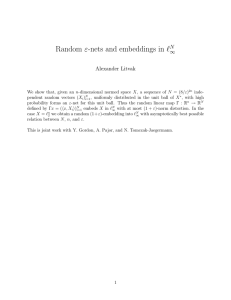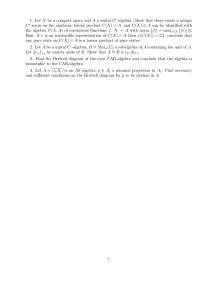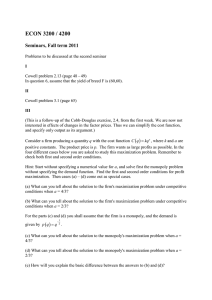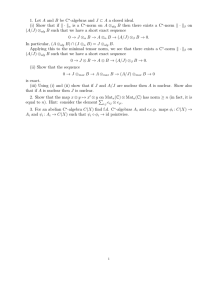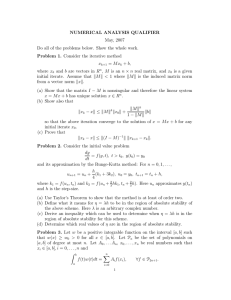Robust Principal Component Analysis with Non-Greedy -Norm Maximization
advertisement
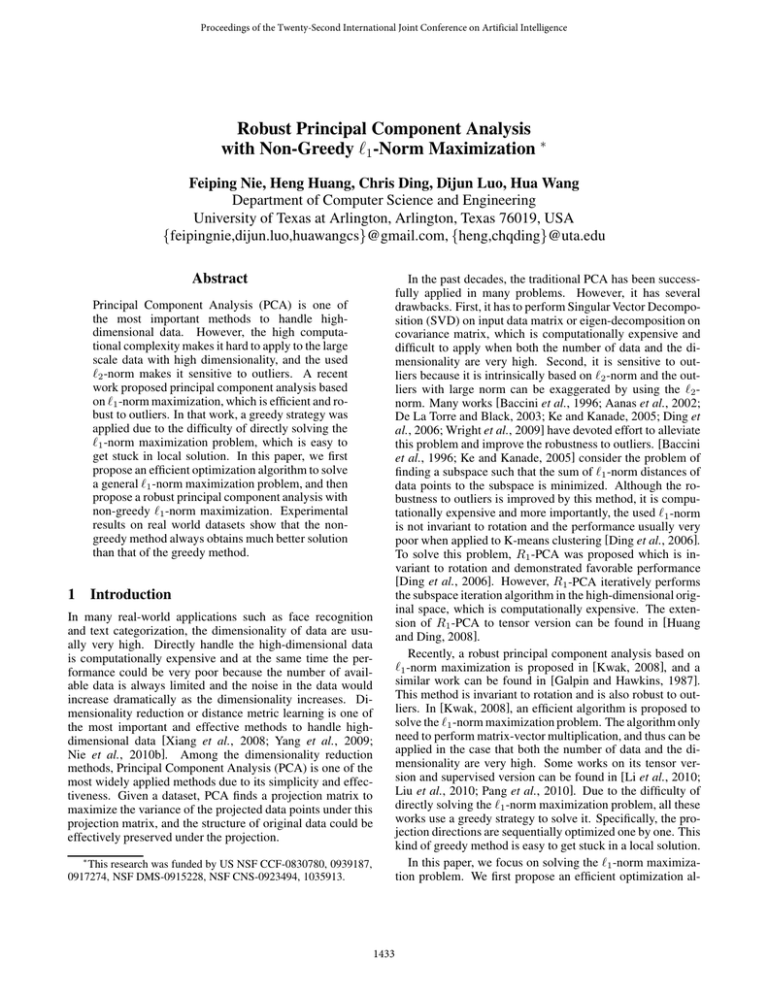
Proceedings of the Twenty-Second International Joint Conference on Artificial Intelligence
Robust Principal Component Analysis
with Non-Greedy 1 -Norm Maximization ∗
Feiping Nie, Heng Huang, Chris Ding, Dijun Luo, Hua Wang
Department of Computer Science and Engineering
University of Texas at Arlington, Arlington, Texas 76019, USA
{feipingnie,dijun.luo,huawangcs}@gmail.com, {heng,chqding}@uta.edu
Abstract
In the past decades, the traditional PCA has been successfully applied in many problems. However, it has several
drawbacks. First, it has to perform Singular Vector Decomposition (SVD) on input data matrix or eigen-decomposition on
covariance matrix, which is computationally expensive and
difficult to apply when both the number of data and the dimensionality are very high. Second, it is sensitive to outliers because it is intrinsically based on 2 -norm and the outliers with large norm can be exaggerated by using the 2 norm. Many works [Baccini et al., 1996; Aanas et al., 2002;
De La Torre and Black, 2003; Ke and Kanade, 2005; Ding et
al., 2006; Wright et al., 2009] have devoted effort to alleviate
this problem and improve the robustness to outliers. [Baccini
et al., 1996; Ke and Kanade, 2005] consider the problem of
finding a subspace such that the sum of 1 -norm distances of
data points to the subspace is minimized. Although the robustness to outliers is improved by this method, it is computationally expensive and more importantly, the used 1 -norm
is not invariant to rotation and the performance usually very
poor when applied to K-means clustering [Ding et al., 2006].
To solve this problem, R1 -PCA was proposed which is invariant to rotation and demonstrated favorable performance
[Ding et al., 2006]. However, R1 -PCA iteratively performs
the subspace iteration algorithm in the high-dimensional original space, which is computationally expensive. The extension of R1 -PCA to tensor version can be found in [Huang
and Ding, 2008].
Recently, a robust principal component analysis based on
1 -norm maximization is proposed in [Kwak, 2008], and a
similar work can be found in [Galpin and Hawkins, 1987].
This method is invariant to rotation and is also robust to outliers. In [Kwak, 2008], an efficient algorithm is proposed to
solve the 1 -norm maximization problem. The algorithm only
need to perform matrix-vector multiplication, and thus can be
applied in the case that both the number of data and the dimensionality are very high. Some works on its tensor version and supervised version can be found in [Li et al., 2010;
Liu et al., 2010; Pang et al., 2010]. Due to the difficulty of
directly solving the 1 -norm maximization problem, all these
works use a greedy strategy to solve it. Specifically, the projection directions are sequentially optimized one by one. This
kind of greedy method is easy to get stuck in a local solution.
In this paper, we focus on solving the 1 -norm maximization problem. We first propose an efficient optimization al-
Principal Component Analysis (PCA) is one of
the most important methods to handle highdimensional data. However, the high computational complexity makes it hard to apply to the large
scale data with high dimensionality, and the used
2 -norm makes it sensitive to outliers. A recent
work proposed principal component analysis based
on 1 -norm maximization, which is efficient and robust to outliers. In that work, a greedy strategy was
applied due to the difficulty of directly solving the
1 -norm maximization problem, which is easy to
get stuck in local solution. In this paper, we first
propose an efficient optimization algorithm to solve
a general 1 -norm maximization problem, and then
propose a robust principal component analysis with
non-greedy 1 -norm maximization. Experimental
results on real world datasets show that the nongreedy method always obtains much better solution
than that of the greedy method.
1 Introduction
In many real-world applications such as face recognition
and text categorization, the dimensionality of data are usually very high. Directly handle the high-dimensional data
is computationally expensive and at the same time the performance could be very poor because the number of available data is always limited and the noise in the data would
increase dramatically as the dimensionality increases. Dimensionality reduction or distance metric learning is one of
the most important and effective methods to handle highdimensional data [Xiang et al., 2008; Yang et al., 2009;
Nie et al., 2010b]. Among the dimensionality reduction
methods, Principal Component Analysis (PCA) is one of the
most widely applied methods due to its simplicity and effectiveness. Given a dataset, PCA finds a projection matrix to
maximize the variance of the projected data points under this
projection matrix, and the structure of original data could be
effectively preserved under the projection.
∗
This research was funded by US NSF CCF-0830780, 0939187,
0917274, NSF DMS-0915228, NSF CNS-0923494, 1035913.
1433
gorithm to solve a general 1 -norm maximization problem.
Theoretical analysis guarantees the algorithm will converge
and usually converge to a local solution. The 1 -norm maximization problem in [Kwak, 2008] is a special case of the
general problem, and thus the proposed optimization algorithm can be used to solve it directly in a non-greedy strategy.
That is, all the projection directions can be optimized simultaneously. Experimental results on real datasets show that the
non-greedy method always obtains much better solution than
that of the greedy method.
The rest of this paper is organized as follows: We give a
brief review of the work [Kwak, 2008] in §2. In §3, we propose an efficient algorithm to solve a general 1 -norm maximization problem and give theoretical analysis on it. Based
on the algorithm, we solve the problem for the principal component analysis with greedy 1 -norm maximization in §4 and
propose a principal component analysis with non-greedy 1 norm maximization in §5. In §6, we present experiments to
verify the effectiveness of the proposed method. Finally, we
draw the conclusions in §7.
2 Related work
Suppose the given data are X = [x1 , x2 , · · · , xn ] ∈ Rd×n ,
where n and d are the number and the dimensionality of
data points respectively. Without loss of generality,
the data
n
{xi }ni=1 are assumed to be centralized, i.e., i=1 xi = 0.
Denote the projection matrix W = [w1 , w2 , · · · , wm ] ∈
Rd×m . Traditional PCA method maximizes the variance of
data in the projected subspace, and to solve the following optimization problem:
max T r(W T St W ),
W T W =I
(1)
where St = n1 XX T is the covariance matrix, I is the identity
matrix and T r(·) is the trace operator of a matrix. Denote the
1 -norm and 2 -norm of a vector by ·1 and ·2 , respectively. The problem (1) can be reformulated as the following
problem:
n
1 W T xi 2 .
max
(2)
2
W T W =I n
i=1
max
W T W =I
1
n
T W xi 1
T w =1
wk
k
n
T wk xi (5)
i=1
In this greedy method, the only problem needed to solve
is the problem (5) for each k. The work in [Kwak, 2008]
proposed an iterative algorithm to solve this problem. The
detailed procedure is:
1) t = 1. Initialize wkt ∈ Rd such that (wkt )2 = 1.
2) For each i, if (wkt )T xi < 0, αi = −1 otherwise αi = 1.
n
3) Let v =
αi xi , and wkt+1 = v/v2 , t = t + 1.
i=1
4) Iteratively perform steps 2 and 3 until converges.
In order to guarantee the algorithm converges to a local
maximum, the algorithm adds an additional judgement after
convergence. If there exists i such that (wkt )T xi = 0, then
let wkt = (wkt + w)/wkt + w2 and go to step 2, where
w is a small nonzero random vector. However, such operation might make the algorithm interminable (for example,
suppose there is a data point x that exactly locates on the
mean of the data set, then x will be zero after centralization,
and thus (wt )T x is always zero for any wt ). Moreover, it
is possible that there exists i such that (wkt )T xi = 0 at the
global maximum. In this case, the algorithm can not have the
chance to find the global maximum.
Subsequently, we will first propose an efficient algorithm
to solve a general 1 -norm maximization problem. Based on
it, we also solve the problem (5) for the principal component
analysis with greedy 1 -norm maximization and propose the
principal component analysis with non-greedy 1 -norm maximization by directly solve the problem (3). The additional
judgement is not required in the new algorithms to obtain a local solution, and the non-greedy method always obtains much
better solution than that of the greedy method in practice.
Consider a general 1 -norm maximization problem as follows
(we assume that the objective has an upper bound) :
|gi (v)|.
(6)
max f (v) +
v∈C
i
where f (v) and gi (v) for each i are arbitrary functions,
and v ∈ C is an arbitrary constraint. Although there are
many methods to solve the 1 -norm minimization problem
in compressed sensing and sparse learning [Donoho, 2006;
Nie et al., 2010a], these methods can not be used to solve the
1 -norm maximization problem.
Rewriting the problem (6) as the following problem:
αi gi (v),
(7)
max f (v) +
(3)
i=1
Directly solving this problem is difficult, thus the author use
a greedy strategy to solve it. Specifically, the m projection directions {w1 , w2 , ..., wm } are optimized one by one. The first
projection direction w1 is optimized by solving the following
problem:
n
T w1 xi max
(4)
w1T w1 =1
max
3 An efficient algorithm to solve a general
1 -norm maximization problem
Motivated by this reformulation, a recent work [Kwak, 2008]
proposed to maximize the 1 -norm instead of the 2 -norm in
PCA, and thus the robustness to outliers is improved. Then
the problem becomes:
n
wk−1 (wk−1 )T X, and then the k-th projection direction wk
is optimized by solving the following problem:
v∈C
i
where αi = sgn(gi (v)), and sgn(·) is the sign function defined as follows: sgn(x) = 1 if x > 0, sgn(x) = −1 if
x < 0, and sgn(x) = 0 if x = 0. Note that αi depends on
i=1
After the (k − 1)-th projection direction wk−1 has been obtained, the data matrix X is transformed to X = X −
1434
v and thus is also a unknown variable. We propose an iterative algorithm to solve the problem (6), and prove that the
proposed iterative algorithm will monotonically increase the
objective of the problem (6) in each iteration, and will usually
converge to a local solution.
The algorithm is described in Algorithm 1. In each iteration, αi is calculated by current solution v, and the solution
v is updated with the current αi . The iterative procedure is
repeated until the algorithm converges.
Theorem 2 The solution of the Algorithm 1 in the convergence will satisfy the KKT condition of the problem (6).
Proof: The Lagrangian function of the problem (6) is
L(v, λ) = f (v) +
|gi (v)| − h(v, λ),
(12)
i
where h(λ, v) is the Lagrangian term to encode the constraint
v ∈ C in problem (6).
Taking the derivative1 of L(v, λ) w.r.t v, and setting the
derivative to zero, we have:
∂L(v, λ)
∂h(v, λ)
αi gi (v) −
= f (v) +
= 0, (13)
∂v
∂v
i
Initialize v 1 ∈ C, t = 1 ;
while not converge do
1. For each i, calculate αti =sgn(gi (v t )) ;
2. v t+1 = arg max f (v) + αti gi (v) ;
v∈C
where αi = sgn(gi (v)).
Suppose the Algorithm 1 converges to a solution v ∗ , from
step 2 in Algorithm 1 we have
α∗i gi (v ∗ ),
(14)
v ∗ = arg max f (v ∗ ) +
i
3. t = t + 1 ;
end
Output: v t .
Algorithm 1: An efficient algorithm to solve a general
1 -norm maximization problem (6).
3.1
v∈C
Theoretical analysis of the optimization
algorithm
The convergence of the Algorithm 1 is demonstrated in the
following theorem:
Theorem 1 The Algorithm 1 will monotonically increase the
objective of the problem (6) in each iteration.
Proof: According to the step 2 in Algorithm 1, for each iteration t we have
f (v t+1 ) +
αti gi (v t+1 ) ≥ f (v t ) +
αti gi (v t ) (8)
i
i
4 Principal component analysis with greedy
1 -norm maximization revisited
For each i, note that
= sgn(gi (v t )), so we
t+1 have that gi (v )
= sgn(gi (v t+1 ))g i (v t+1 ) ≥
t
t+1
sgn(gi (v ))gi (v ) = αti gi (v t+1 ). Then gi (v t+1 ) ≥
αti gi (v t+1 ) and note that |gi (v t )| − αti gi (v t ) = 0, we have:
gi (v t+1 ) ≥ αti gi (v t+1 )
⇒ gi (v t+1 ) − αti gi (v t+1 ) ≥ 0
(9)
⇒ gi (v t+1 ) − αti gi (v t+1 ) ≥ gi (v t ) − αti gi (v t )
αti
Recall that the principal component analysis with greedy 1 norm maximization only need to solve the following problem:
n
T w xi .
(15)
max
w T w=1
i
(10)
Combining Eq. (8) and Eq. (10), we arrive at
gi (v t+1 ) ≥ f (v t ) +
gi (v t )
f (v t+1 ) +
i
i=1
As described in Section 2, an algorithm proposed in [Kwak,
2008] can solve it. In this section, we solve it based on the
Algorithm 1, and compare the differences between these two
algorithms. According to the Algorithm 1, the key step to
solve the problem (15) is to solve the following problem:
n
max
αi wT xi ,
(16)
Eq. (9) holds for every i, thus we have
(gi (v t+1 ) − αti gi (v t+1 )) ≥
(gi (v t ) − αti gi (v t ))
i
i
where α∗i = sgn(gi (v ∗ )). According to the KKT condition
[Boyd and Vandenberghe, 2004] of the problem in Eq. (14),
we know that the solution v ∗ satisfies Eq. (13), which is the
KKT condition of the problem (6).
In general, satisfying the KKT condition usually indicates
that the solution is a local optimum solution. Theorem 2 indicates that the Algorithm 1 will usually converge to a local
solution.
We can see that both the problem (5) and the problem (3)
are the special cases of the problem (6), so we can use the
proposed Algorithm 1 to solve these two problems. The key
step of the Algorithm 1 is to solve the problem in step 2. In the
next two sections, we give detailed derivation and algorithm
to solve the problem (5) and the problem (3), respectively.
w T w=1
(11)
i=1
where αi = sgn((wt )T xi ). Denote m =
i
Thus the Algorithm 1 will monotonically increase the objective of the problem (6) in each iteration t.
As the objective of the problem (6) has an upper bound,
Theorem 1 indicates that the Algorithm 1 will converge. The
following theorem shows that the solution in the convergence
will satisfy the KKT condition.
1435
can rewrite the problem (16) as
max wT m,
w T w=1
n
αi xi , then we
i=1
(17)
1
When x = 0, 0 is a subgradient of function |x|, so sgn(x) is
the gradient or a subgradient of the function |x| in all the cases.
The Lagrangian function of the above problem is
L(w, λ) = w m − λ(w w − 1),
T
T
Input: X, m, where X is centralized
Initialize W 1 ∈ Rd×m such that W T W = I, t = 1 ;
while not converge do
n
1. αi = sgn((W t )T xi ), M =
xi αTi ;
(18)
Taking the derivative of L(w, λ) w.r.t w, and setting the
derivative to zero, we have w = m/λ. Then λ = m2 according to the constraint wT w = 1. So the optimal solution
to the problem (16) is w = m/m2.
Based on the Algorithm 1, the algorithm to solve the principal component analysis with greedy 1 -norm maximization
is described in Algorithm 2. We can see that the Algorithm
2 is almost the same as the one described in Section 2, except that the values of αi are different when (wkt )T xi = 0
and the Algorithm 2 does not have the additional judgement
when the algorithm converges. When (wkt )T xi = 0, αi = 0
in Algorithm 2 while αi = 1 in the algorithm proposed in
[Kwak, 2008]. Using the Algorithm 2 without the additional
judgement, we can also obtain a local solution according to
Theorem 2.
From Algorithm 2 we can see that the algorithm is efficient
and only involves matrix-vector multiplication. The computational complexity is O(ndmt), where n, d, m is the number of data, dimension of original data and the dimension of
the projected data respectively, and t is the iterative number.
In practice, the algorithm usually converges in ten iterations.
Therefore, the computational complexity of the algorithm is
linear w.r.t both data number and data dimension, which indicates the algorithm is applicable in the case that both data
number and data dimension are very high. If the data are
sparse, the computational complexity is further reduced to
O(nsmt), where s is the averaged number of non-zeros elements in a data point.
i=1
2. Calculate the SVD of M as M = U ΛV T , Let
W t+1 = U V T ;
3. t = t + 1 ;
end
Output: W t ∈ Rd×m .
Algorithm 3: Principal component analysis with nongreedy 1 -norm maximization.
Since directly solving this problem is difficult, [Kwak, 2008]
turns to solve it by a greedy method. In this paper, we propose
a non-greedy method to directly solve the problem (19).
Based on the Algorithm 1, the key step to solve the problem
(19) is to solve the following problem:
max
W T W =I
αTi W T xi
(20)
i=1
where the vectors αi = sgn((W t )T xi ). Denote M =
n
xi αTi , then we can rewrite the problem (20) as
i=1
max T r(W T M )
(21)
W T W =I
Suppose the SVD of M is M = U ΛV T , then T r(W T M )
can be rewritten as:
T r(W T M ) =
Input: X, m, where X is centralized
Initialize W = [w1 , w2 , ..., wm ] ∈ Rd×m such that
WTW = I ;
for k = 1 to m do
Let wk1 = wk , t = 1 ;
while not converge do
1. αi = sgn((wkt )T xi ) ;
n
αi xi , and wkt+1 = m/m2 ;
2. m =
=
=
T r(W T U ΛV T )
T r(ΛV T W T U )
T r(ΛZ) =
λii zii
(22)
i
where Z = V T W T U , λii and zii are the (i, i)-th element of
matrix λ and Z respectively.
Note that Z is an orthonormal matrix, i.e. Z T Z = I, so
zii ≤ 1. On the other hand, λii ≥ 0 since
λii is singular
value of M . Therefore, T r(W T M ) =
λii zii ≤
λii ,
i=1
3. t = t + 1 ;
end
Let X = X − wkt (wkt )T X and wk = wkt ;
end
Output: W ∈ Rd×m .
Algorithm 2: Principal component analysis with greedy
1 -norm maximization.
i
i
and when zii = 1(1 ≤ i ≤ c), the equality holds. That is to
say, T r(W T M ) reaches the maximum when Z = I. Recall
that Z = V T W T U , thus the optimal solution to the problem
Eq. (21) is
W = U ZT V T = U V T .
(23)
Based on the Algorithm 1, the algorithm to solve the principal component analysis with non-greedy 1 -norm maximization is described in Algorithm 3. According to Theorem 2,
we can usually obtain a local solution.
From Algorithm 2 we can see that the algorithm is also efficient. Note that n m in practice, thus the computational
complexity of the algorithm is O(ndmt), which is the same
as that of the greedy method. Similarly, the algorithm usually
converges in ten iterations in practice. Therefore, the computational complexity of the algorithm is also linear w.r.t both
5 Principal component analysis with
non-greedy 1 -norm maximization
The original problem in [Kwak, 2008] is to solve the following problem:
n
T W xi .
max
(19)
1
W T W =I
n
i=1
1436
9000
9000
8000
8000
Size
213
575
165
1440
2000
9298
Dimensions
1024
644
3456
1024
256
256
Classes
10
20
15
20
100
10
7000
Objective
Data set
Jaffe
Umist
Yale
Coil20
Palm
USPS
Objective
10000
Table 1: Dataset Descriptions.
7000
6000
5000
6000
5000
4000
4000
3000
3000
PCA−L1greedy
PCA−L1nongreedy
2000
5
15
25
35
45 55 65
Dimension
75
85
PCA−L1greedy
PCA−L1nongreedy
2000
95
5
15
(a) Jaffe
25
35
45 55 65
Dimension
75
85
95
(b) Umist
4
4
x 10
x 10
3
1.8
1.6
2.5
data number and data dimension, which indicates the algorithm is applicable in the case that both data number and data
dimension are very high. If the data are sparse, the computational complexity is further reduced to O(nsmt).
U T U=Ir1 ,V T V =Ic1
1.2
1
0.6
PCA−L1greedy
PCA−L1nongreedy
(24)
i=1
As in other tensor method, problem (24) can be solved by
alternative optimization technique (also named block coordinate descent). Specifically, when fixing U , the problem (24)
reduced to the problem (19), and thus the V can be optimized
by Algorithm 3. Similarly, U can also be optimized by Al-
1437
15
25
35
45 55 65
Dimension
75
85
PCA−L1greedy
PCA−L1nongreedy
0.4
95
5
15
(c) Yale
25
35
45 55 65
Dimension
75
85
95
(d) Coil20
8000
70
7000
60
6000
Objective
Similar to traditional PCA, the robust principal component
analysis with 1 -norm maximization is also a linear method,
and is difficult to handle data well with non-Gaussian distribution. A popular technique to deal with this problem is
extending the linear method to kernel method. Obviously, the
robust principal component analysis with 1 -norm maximization is invariant to rotation and shift, so this linear method
satisfies the conditions in a generalized kernel framework in
[Zhang et al., 2010], and thus can be kernelized using the
framework. Specifically, the given data are transformed by
KPCA [Schölkopf et al., 1998], and then perform Algorithm
3 using the transformed data as input.
Another problem of the principal component analysis is
that the method can only handle vector data. For 2D tensor
or higher order tensor data, we have to vectorize the data to
very high-dimensional vectors in order to apply this method.
This approach will destroy the structural information of tensor data and also make the computational burden very heavy.
A popular technique to deal with this problem is extending
the vector method to tensor method. As the problem (19) of
the principal component analysis with 1 -norm maximization
only includes linear operator W T xi , it can be easily extended
to the tensor method to handle tensor data directly. For simplicity, we only briefly discuss the case of 2D tensor, high order tensor cases can be readily extended by replacing the linear operator W T xi with tensor operator [Lathauwer, 1997].
Suppose the given data are X = [X1 , X2 , ..., Xn ] ∈
Rr×c×n , where each data Xi ∈ Rr×c is a 2D tensor, n is the
n
number of data points.
n Similarly, we assume that {Xi }i=1
are centered, i.e., i=1 Xi = 0.
In the 2D tensor case, linear operator W T xi is replaced by
T
U Xi V , where U ∈ Rr×r1 and V ∈ Rc×c1 are two projection matrices. Correspondingly, the problem (19) becomes:
n
T
U Xi V 1
Objective
Objective
1
0.5
5
Extensions to kernel and tensor cases
max
1.5
0.8
Objective
5.1
1.4
2
5000
4000
50
40
30
3000
PCA−L1greedy
PCA−L1nongreedy
2000
5
15
25
35
45 55 65
Dimension
(e) Palm
75
85
95
20
5
PCA−L1greedy
PCA−L1nongreedy
15
25
35
45 55 65
Dimension
75
85
95
(f) USPS
Figure 1: Objective values in Eq. (3) with different dimensions obtained by PCA-1 greedy and PCA-1 nongreedy, respectively.
gorithm 3 when fixing V . The procedure is iteratively performed until converges.
6 Experiments
In this section, we present experiments to demonstrate the
effectiveness of the proposed principal component analysis
with non-greedy 1 -norm maximization (denoted by PCA1 nongreedy) compared to the greedy method (denoted by
PCA-1 greedy).
We use six image datasets from different domains to perform the experiments. A brief description of the datasets are
shown in Table 1. In this experiment, we study the greedy and
non-greedy optimization methods, and compare the objective
values in Eq.(3) obtained by these two optimization methods.
In the first experiment, we run the greedy method and the
non-greedy method with different projected dimensions m
and the same initialization on each dataset. The projected
dimensions varies from 5 to 100 with the interval 5. The results are shown in Figure 1. In the second experiment, we run
the greedy method and the non-greedy method 50 times with
the projected dimensions m = 50 on each dataset. In each
time, the two methods use the same initialization. The results
are shown in Table 2.
From Figure 1 and Table 2 we can see, the proposed nongreedy method obtains much higher objective values than that
of the greedy method in all the cases. The results indicate that
Table 2: Objective values in Eq.(3) with dimension 50 obtained by PCA-1 greedy and PCA-1 nongreedy, respectively. The
number of initialization is 50.
Data set
PCA-1 greedy
PCA-1 nongreedy
Min
Max
Min/Max
Mean
Min
Max
Min/Max
Mean
Jaffe
4722.86
4815.28
0.9808
4770.50
7349.87
7409.23
0.9920
7377.96
Umist
4649.03
4673.87
0.9947
4661.83
6316.97
6359.19
0.9934
6340.59
Yale
16058.68 16261.68
0.9875
16144.79 20964.16 21217.98
0.9880
21064.38
Coil20
8753.97
8793.97
0.9955
8778.63
12860.50 12935.98
0.9942
12891.44
Palm
4497.48
4518.04
0.9954
4507.50
5702.38
5724.27
0.9962
5712.15
USPS
34.44
34.47
0.9992
34.45
50.26
50.49
0.9954
50.39
the proposed non-greedy method always obtains much better
solution to the 1 -norm maximization problem (3) than the
pervious greedy method.
7 Conclusions
A robust principal component analysis with non-greedy 1 norm maximization is proposed in this paper. We first propose an efficient optimization algorithm to solve a general 1 norm maximization problem, and the algorithm will usually
converge to a local solution by theoretical analysis. Based on
the algorithm, we directly solve the 1 -norm maximization
problem where the projection directions are optimized simultaneously. Similarly to the previous greedy method, the robust principal component analysis with non-greedy 1 -norm
maximization is also efficient, and is easy to extend to its
kernel version or tensor version. Experimental results on six
real world image datasets show that the proposed non-greedy
method always obtains much better solution than that of the
greedy method.
References
[Aanas et al., 2002] H. Aanas, R. Fisker, K. Astrom, and J.M.
Carstensen. Robust factorization. IEEE Transactions on PAMI,
24(9):1215–1225, 2002.
[Baccini et al., 1996] A. Baccini, P. Besse, and A. de Faguerolles.
A L1-norm PCA and heuristic approach. In Proceedings of the
International Conference on Ordinal and Symbolic Data Analysis, volume 1, pages 359–368, 1996.
[Boyd and Vandenberghe, 2004] S.P. Boyd and L. Vandenberghe.
Convex optimization. Cambridge University Press, 2004.
[De La Torre and Black, 2003] F. De La Torre and M.J. Black. A
framework for robust subspace learning. International Journal
of Computer Vision, 54(1):117–142, 2003.
[Ding et al., 2006] Chris H. Q. Ding, Ding Zhou, Xiaofeng He, and
Hongyuan Zha. R1-PCA: rotational invariant L1-norm principal
component analysis for robust subspace factorization. In ICML,
pages 281–288, 2006.
[Donoho, 2006] David L. Donoho. Compressed sensing. IEEE
Transactions on Information Theory, 52(4):1289–1306, 2006.
[Galpin and Hawkins, 1987] J.S. Galpin and D.M. Hawkins. Methods of L1 estimation of a covariance matrix. Computational
Statistics & Data Analysis, 5(4):305–319, 1987.
[Huang and Ding, 2008] Heng Huang and Chris H. Q. Ding. Robust tensor factorization using r1 norm. In CVPR, 2008.
1438
[Ke and Kanade, 2005] Q. Ke and T. Kanade. Robust L1 norm factorization in the presence of outliers and missing data by alternative convex programming. In CVPR, pages 739–746, 2005.
[Kwak, 2008] N. Kwak. Principal component analysis based on L1norm maximization. IEEE Transactions on PAMI, 30(9):1672–
1680, 2008.
[Lathauwer, 1997] Lieven De Lathauwer. Signal Processing based
on Multilinear Algebra. PhD thesis, Faculteit der Toegepaste
Wetenschappen. Katholieke Universiteit Leuven, 1997.
[Li et al., 2010] Xuelong Li, Yanwei Pang, and Yuan Yuan. L1norm-based 2DPCA. IEEE Transactions on Systems, Man, and
Cybernetics, Part B, 38(4), 2010.
[Liu et al., 2010] Yang Liu, Yan Liu, and Keith C. C. Chan. Multilinear maximum distance embedding via l1-norm optimization.
In AAAI, 2010.
[Nie et al., 2010a] Feiping Nie, Heng Huang, Xiao Cai, and Chris
Ding. Efficient and robust feature selection via joint 2,1 -norms
minimization. In NIPS, 2010.
[Nie et al., 2010b] Feiping Nie, Dong Xu, Ivor Wai-Hung Tsang,
and Changshui Zhang. Flexible manifold embedding: A framework for semi-supervised and unsupervised dimension reduction. IEEE Transactions on Image Processing, 19(7):1921–1932,
2010.
[Pang et al., 2010] Yanwei Pang, Xuelong Li, and Yuan Yuan. Robust tensor analysis with L1-norm. IEEE Transactions on Circuits and Systems for Video Technology, 20(2):172–178, 2010.
[Schölkopf et al., 1998] Bernhard Schölkopf, Alex J. Smola, and
Klaus-Robert Müller. Nonlinear component analysis as a kernel eigenvalue problem. Neural Computation, 10(5):1299–1319,
1998.
[Wright et al., 2009] J. Wright, A. Ganesh, S. Rao, and Y. Ma. Robust principal component analysis: Exact recovery of corrupted
low-rank matrices via convex optimization. NIPS, 2009.
[Xiang et al., 2008] Shiming Xiang, Feiping Nie, and Changshui
Zhang. Learning a mahalanobis distance metric for data clustering and classification. Pattern Recognition, 41(12):3600–3612,
2008.
[Yang et al., 2009] Yi Yang, Yueting Zhuang, Dong Xu, Yunhe Pan,
Dacheng Tao, and Stephen J. Maybank. Retrieval based interactive cartoon synthesis via unsupervised bi-distance metric learning. In ACM Multimedia, pages 311–320, 2009.
[Zhang et al., 2010] Changshui Zhang, Feiping Nie, and Shiming
Xiang. A general kernelization framework for learning algorithms based on kernel PCA. Neurocomputing, 73(4-6):959–967,
2010.
